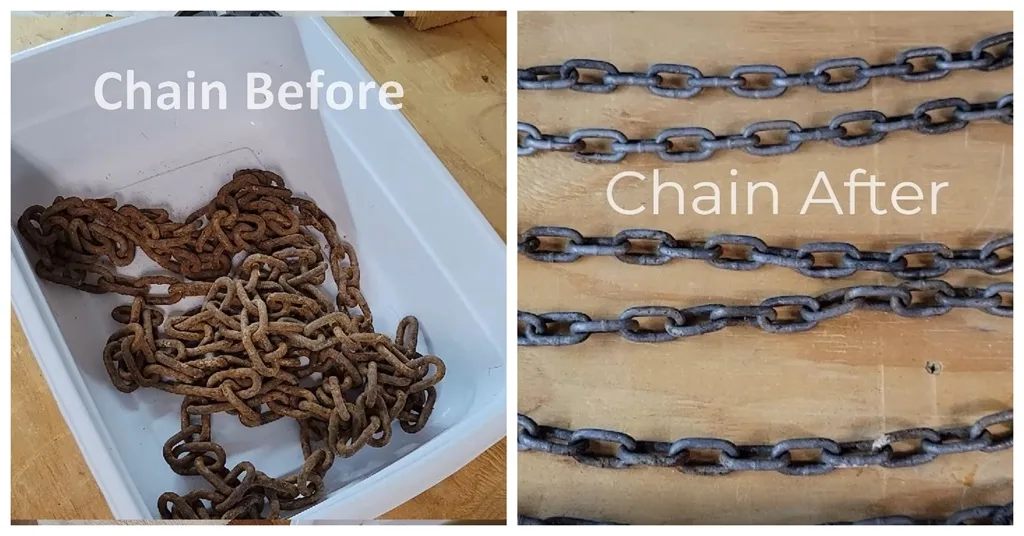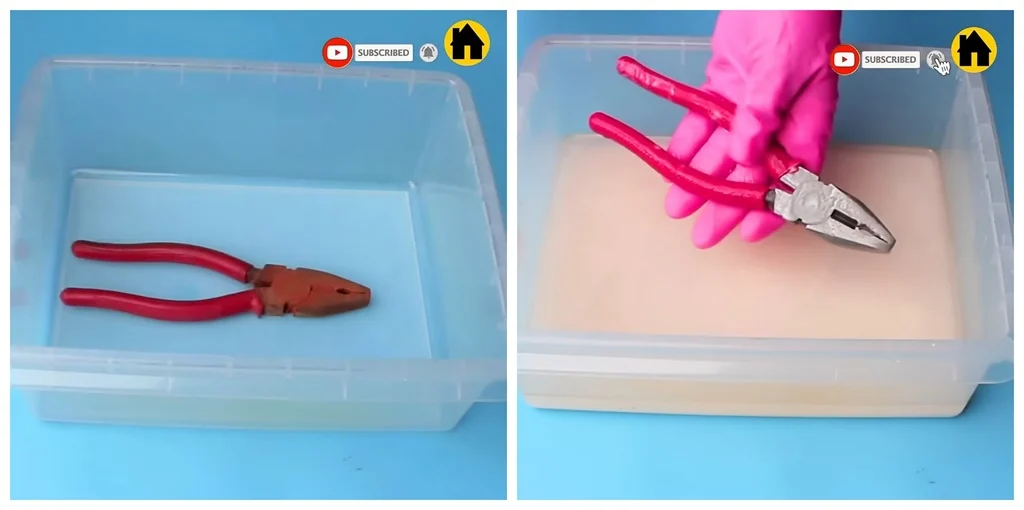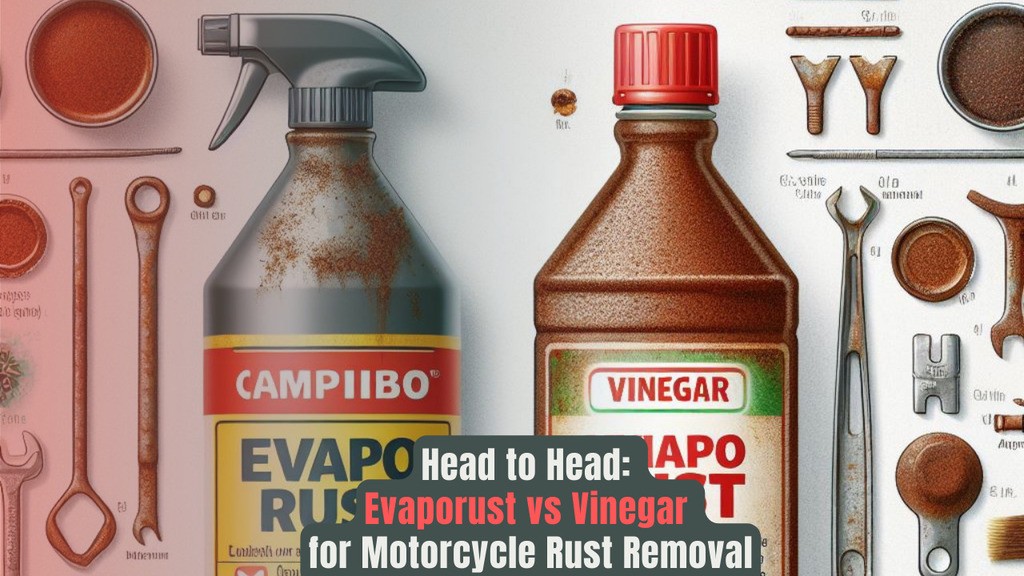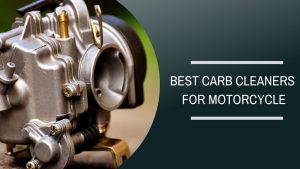🎯 Key Takeaways
- Evaporust uses a safe, pH-neutral chelating process that targets only rust, not the metal underneath.
- White vinegar uses acetic acid to dissolve rust.
- Evaporust is better for heavily rusted or pitted parts.
- Vinegar is better for light rust jobs tight or intricate areas where thicker liquids can’t reach.
You lift the seat on your vintage Honda and see rust swirling inside the tank. Makes your heart sink! Or maybe you’re rebuilding that old Yamaha you found in a barn.
Either way, the rust has to go. Trick is doing it without messing with the vintage paint job you’ve worked so hard to preserve.
That’s where products like Evaporust and good old white vinegar come in. They promise to dissolve the rust while leaving your paint or patina intact.
But which one really works better for motorcycle applications? And which is going to be easier on your wallet?
I’m going to share my experience testing Evaporust vs vinegar side by side.
1. Quick Comparison Table
| Feature | Evaporust | White Vinegar |
|---|---|---|
| Rust Removal Effectiveness | Very strong and cleans fast even pitted rust | Good on light to moderate rust, slower on heavy |
| Residue Left Behind | A bit greasy; needs a little degreaser | Clean; rinses off with water fully |
| Paint/Safety | Safe but leaves slight residue | Very safe; leaves no trace |
| Hard-to-Reach Rust | Good, yet surface tension may trap air | Excellent, thin and seeps into tight crevices |
| Reusability | Reusable until it turns dark black | Reusable, but effectiveness drops over time |
| Cost | Check price (around $20‑30 per gallon) | Check price (around $10 per gallon) |
| Best Use Case | Fast heavy-duty jobs, tough embedded rust | Budget jobs or fiddly spots with light rust |
NOTE: While both products work, Evaporust provides better overall rust removal, especially for embedded or heavy rust. White vinegar is good for low-rust areas and budget projects.
Evaporust vs Vinegar: How Do They Work?
Evaporust
Evaporust works through a chelation process. That’s a fancy way of saying it uses safe, water-based molecules that grab onto rust (iron oxide) and break its bond with the metal underneath. It literally lifts the rust off your part without eating into good steel, aluminum, paint, or chrome.
Here’s what makes it special:
- No acid, no base, it’s pH neutral.
- Safe on skin, plastics, rubber, paint, and even chrome.
- Works well even at room temperature.
- You don’t need gloves (though it’s still smart to wear them).
- You can pour it back into a jug and reuse it later, until it turns black.
Unlike vinegar or harsh acids, Evaporust doesn’t attack the metal beneath the rust. That means no pitting, no loss of detail, and no chance of ruining vintage parts. It’s the “smart bomb” of rust removal.
White Vinegar
White vinegar is made of 5% acetic acid. This acid reacts with rust and slowly dissolves it into a water-soluble form (iron acetate). When you rinse it away, the rust comes off with it.
It’s safe and natural, but not as precise. Vinegar doesn’t know what’s rust and what’s soft metal—so it can start eating into aluminum, zinc, or weak steel if you leave it too long. That’s why timing and rinsing matter more with vinegar.
Still, vinegar has two big strengths:
- It’s super cheap. A gallon costs just a few bucks.
- It’s incredibly thin, which means it seeps into tight crevices that thicker liquids like Evaporust sometimes can’t reach.
Want more power? Mix vinegar with salt. That boosts conductivity and speeds up the acid’s action. Just make sure to rinse really well after, or you’ll get flash rust.
The Pros and Cons
Evaporust
- Pros: Fast; effective on severe rust; paint-safe; reusable; non-toxic.
- Cons: Pricier; leaves greasy residue; needs full submersion; turns dark and loses effectiveness over time.
White Vinegar
- Pros: Super cheap; flushes clean; seeps into tight spots; safe.
- Cons: Slower; can weaken soft metal if overused; not great on deep pitting.
Evaporust vs White Vinegar: Side-by-Side Test
It was time to really see how Evaporust stacks up against white vinegar for tackling motorcycle rust.
To give each method a fair shot, I set up a side-by-side comparison using some rusty parts I had laying around.
Test Setup for Rusty Motorcycle Parts
For this Evaporust vs vinegar smackdown, I used some rusty tools. I submerged one set in a container filled with Evaporust. For the other, it was a diluted white vinegar solution with some salt tossed in per the usual recipe.
To monitor progress, I’d take the pieces in and out every 4 hours to inspect how much rust was loosening up.
I made sure to agitate the vinegar parts a bit each time to mimic scrubbing as it worked. Temperature was around 65°F/18°C in my garage.
After a day of soaking, I was eager to see which common rust remover would reign supreme in the evaporust vs vinegar match! Keep reading to find out which method earned bragging rights.
The Results Are IN!
After giving the rust removal methods a day to work their magic, it was time to see how the parts looked.
When I removed the rearsets from their Evaporust vs vinegar baths, I was actually pretty surprised by what I found!
The Evaporust had done a solid job on the tools. Most of the rust was now flaky and brushed right off. Some stubborn spots remained but not too bad overall.

The white vinegar parts weren’t still fully clean. Just to be thorough, I agitated the vinegar parts a bit more under running water.
Sure enough, more rust streaks came away with each rinse to reveal smooth metal beneath.

Both methods worked well enough, but Evaporust eradicated rust more fully with less effort on my part.
Aftermath: What’s Left Behind?
Now that the rust removal battle was won, I took a closer look at what kind of aftermath each method left on the treated parts. This is important to consider depending on where you plan to use Evaporust vs white vinegar.
With the Evaporust-soaked rearsets, I noticed a slight waxy, greasy film leftover on areas it had splashed.
Not a huge amount, but a noticeable smear none the less. Working it off required some extra elbow grease and degreaser.
This residue could potentially cause issues if Evaporust gets inside places you don’t want mystery goop residing.
Like the inside of gas tanks or hard to clean areas. That greasy streak took a while to fully wash away too.
On the other hand, the white vinegar parts were pristine! Not a trace of residue at all after a simple rinse. The rust had fully dissolved away, leaving smooth, dry metal.
No doubt this makes vinegar the safer choice if you don’t want to risk any unwanted remnants.
Especially for jobs where you need to fully flush out the metal afterward without oily streaks. Evaporust leaves a slightly messier aftermath to deal with.
Evapo-Rust ER012 Super Safe – 128 oz., Non Toxic Rust Remover for Auto Parts, Hardware, Antiques

Iberia All Natural Distilled White Vinegar, 1 Gallon – 5% Acidity (Pack of 2)

Evaporust and Vinegar: Are They Paint Safe?
One major concern when busting rust is preserving any original paint or plating that remains. So let’s discuss how well Evaporust and white vinegar back up their claims of being paint-safe.
How Do They Treat Paint?
One major concern when busting rust is preserving any original paint or plating that remains. As advertised, I can confirm neither caused any visible damage even to delicate old finishes after prolonged soaks.
Both Evaporust and white vinegar kept original colors intact as rust was dissolved.
However, I did notice one subtle difference in how each treated surfaces. With Evaporust, the lubricating residue left a faint greasy sheen on paint that had to be wiped away.
Vinegar on the other hand left pristine paint that looked and felt completely untouched. No need for additional cleaning or protection of surfaces.
Its total lack of residue is ideal for preserving patinas down to the microscopic level.
Avoid Over Application
While Evaporust and vinegar will not directly damage paint when used correctly, over application could potentially lead to unintended consequences on delicate surfaces. Knowing when to stop is key.
With extended soaking times, I noticed Evaporust’s residue buildup increased on test parts. Excessive splashing around could leave unsightly smears on original colors if not cleaned promptly. Best to limit submersion periods.
Vinegar was more forgiving, but repeated brushing in one spot began to ever so slightly dull paint sheen over days of use. Rinsing thoroughly between applications erased any effect. Moderation is smart here as well.
For both products, less is generally more when it comes to preserving pristine paintwork. Clear away residue often with Evaporust to avoid building up grime. And don’t over-agitate vinegar solutions on one small area for too long.
If the urge to scrub lingers, it may be best to remove trim or break parts down further before rust busting decorated pieces. Better to introduce the least risk of mishap near fragile old finishes.
Pro Tips for Best Results
Rust removal isn’t just “drop it in and forget it.” A few simple tricks can make a huge difference—whether you’re using Evaporust or vinegar. Here are the best tips from mechanics, restorers, and DIYers.
1. Warm It up for Speed
Both Evaporust and vinegar work faster in warm temperatures. Chemical reactions speed up as the temperature rises.
- Place your soak container somewhere warm (like a sunny garage).
- Aim for 80–100°F (27–38°C) if possible.
- You can even warm vinegar slightly on the stove, just don’t boil it.
“In hot weather vinegar just eats the rust alive. Works 10x faster.” – Reddit
2. Agitate the Parts Occasionally
Give the parts a little movement while they soak. Swirl them gently or use tongs to shake them every few hours. This helps break up loosened rust and exposes fresh layers for the remover to act on.
For vinegar especially, light brushing between soaks helps lift stuck-on rust.
3. Use an Ultrasonic Cleaner (Optional but Powerful)
Evaporust in an ultrasonic cleaner is a game-changer for small or detailed parts like bolts, clips, or washers.
- The ultrasonic waves shake rust loose while the solution dissolves it.
- Works even better than brushing and cuts soak times in half.
“Works amazing in my ultrasonic cleaner. Parts come out perfect.” – Garage Journal
4. Reuse Your Solution (Smartly)
You don’t have to dump it after one use.
- Let the used solution sit for a day.
- Rust particles will settle at the bottom.
- Carefully pour the clear liquid into a clean container.
- Store sealed and away from light.
Evaporust works until it turns almost black. Vinegar can be reused too, but it slowly loses acidity, so it becomes less effective over time.
5. Fully Submerge the Parts
Avoid partial dips. If only part of a piece sits in solution, it may leave a hard line or black residue where air meets liquid.
Make sure the entire part is covered, or rotate it often during soaking.
6. Rinse & Dry Immediately
After rust removal, rinse everything thoroughly with clean water.
Then:
- Dry parts right away using a towel, heat gun, or compressed air.
- Apply a thin coat of oil (like WD-40) to prevent flash rust.
Flash rust can form in minutes if the metal is bare and humid air is around. Don’t wait.
7. Use Vinegar for Tight Spots
Vinegar is super thin. It flows into tight areas that Evaporust may miss due to surface tension.
If you’re working on crevices, seams, or tank interiors, vinegar might be your best first step.
“Vinegar creeps into the tiniest spots. Evaporust didn’t reach the bottom of a frame tab.” – Garage Journal
8. Don’t Soak Too Long
- With vinegar: after 24–48 hours, you risk eating into soft metals.
- With Evaporust: safe for longer periods, but it can leave residue if over-soaked or not rinsed.
Check progress every few hours. You’ll get a feel for how fast it’s working.
The Cost Breakdown of Evaporust and Vinegar
When it comes to DIY rust removal, upfront costs matter. So let’s crunch some numbers on typical Evaporust vs white vinegar prices to treat anything from small parts to full motorcycle tanks.
A standard 1-gallon bottle of Evaporust goes for slightly higher than $30. This would treat many small rusted bolts, fittings or minor parts. But for say, a 20L tank, you’d spend $100+ on multiple bottles.
Contrast that to a simple gallon of distilled white vinegar at around $10. It would take several gallons max to submerge even a large tank. So, around $30 or $40 treatment for the same task.
However, you can reuse Evaporust. Let the used chemical sit for a while, waiting for the sediment to settle down. The pour it (without agitating the sediment) into the gallon or where you want to keep it.
Since it does not have a shelf life, it will not expire if kept properly sealed. You need to discard it only when it’s color turn into almost black from its usual light yellow.
You can also reuse vinegar the same way until it completely loses its effectiveness.
For bigger rust removal jobs like frames, fenders or cases, the savings multiply quickly in vinegar’s favor. A few buckets would tackle any project for $20-30 at most.
Putting Evaporust and Vinegar to Best Use Recommendations
After thoroughly testing both Evaporust and white vinegar side by side, I’ve come up with some recommendations on preferred use cases and application tips for each rust busting product:
- For light surface rust on small parts, either will work great. Evaporust may be a tad quicker if agitation isn’t possible.
- Evaporust also reigns supreme for heavier pitted jobs thanks to superior penetration. Some scrubbing aids the process.
- Intricate areas are where vinegar really shines too, creeping easily into confined spaces.
- If rust is embedded all around a part, like say a tank interior, nothing cleans more completely than an acid bath!
- Always use proper ventilation with both Evaporust and vinegar and work in a well lit area for safety.
- Dilute vinegar as instructed for best results.
FAQs
Can I reuse Evaporust and vinegar safely?
Evaporust remains effective until it darkens and should be replaced when it’s spent. Vinegar can also be reused, though its acidity fades over time, so effectiveness declines.
Is Evaporust safe on paint and metal finishes?
Evaporust is pH-neutral, non-corrosive, and safe on most metals, plastics, and paint. But avoid Cadmium-plated parts, Evaporust can strip these finishes.
How long should I soak parts in Evaporust?
Small parts may need 15 minutes to a few hours. Heavily rusted parts might require overnight or up to 72 hours. Check periodically and rinse promptly when clean.
Can vinegar damage soft metals or finishes?
Yes. While vinegar dissolves rust, it can also attack softer metals or coatings if left too long. Rinse promptly and test on tiny areas first.
What’s the best way to dispose of spent Evaporust?
Evaporust is biodegradable, non-toxic, and sewer-safe in most areas. Dispose of it following local regulations. Darkened baths may contain iron but remain environmentally benign.
Is heat helpful in rust removal?
Yes. Heating Evaporust or vinegar greatly speeds up rust removal by accelerating the chemical reaction. Just avoid damaging delicate parts.




